| View previous topic :: View next topic |
| Author |
Message |
stevemark

Joined: 29 Apr 2011
Posts: 3754
Location: Switzerland
|
 Posted: Thu Dec 10, 2020 4:53 pm Post subject: Posted: Thu Dec 10, 2020 4:53 pm Post subject: |
 |
|
stevemark wrote:
Probably the most sophisticated analog SLR ever built - the Minolta Dynax 7 (also known as Maxxum 7). Here's a nice set I just got yesterday, including the Minolta AF 3.5-4.5/24-105mm zoom, the Minolta AF 2/28mm fast wideangle and a 3600 HS D flash.
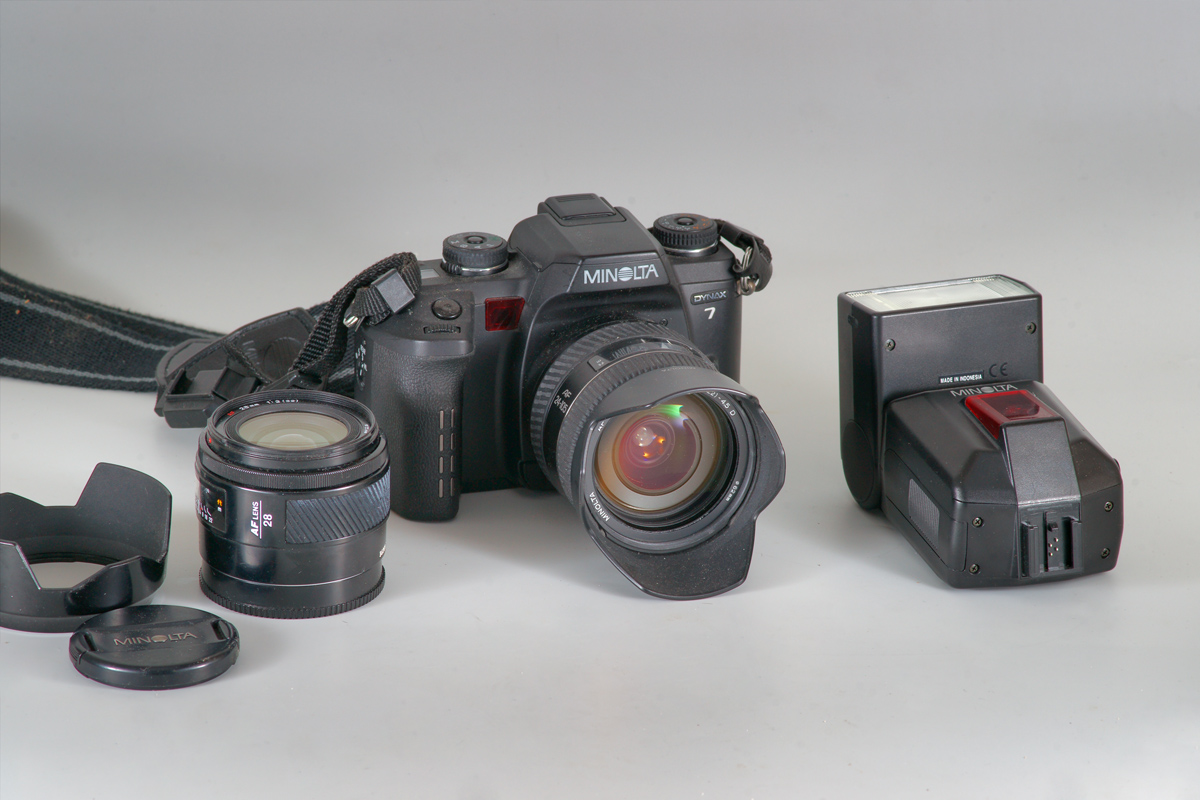
The Dynax 7 has a few features one would expect from a digital SLR, but not from a film camera - such as a kind of EXIF data recording, a LCD monitor on the back (which makes her look like an early DSLR), and lots of buttons.
EDIT:
Here's the rear side 

Doesn't she look like a real early DSLR? In fact around 1995-2000 Minolta did produce some of the technologically most advanced DSLRs. Sadly, the then head of Minolta (the son of its founder) was stubbornly convinced that digital photography would never succeed. It was his decision that the extremely expensive early Minolta DSLR (RD-175 [1995], and RD-3000 [1999]) would be put into the cheapest plastic SLR bodies available - and not into the beautiful full metal (stainless steel!) body of the Dynax 9!
So in the year 2000 the Dynax 7 was born. Would it have been a digital SLR (as the engineers wanted it to be) I'm pretty sure Minolta would still sell cameras today. When finally in 2004 the digital Dynax 7D came out, it was too late, even though the Dynax 7D is extremely well made given the fact that it is not a professional DSLR.
S
_________________
www.artaphot.ch
Last edited by stevemark on Wed Dec 23, 2020 3:59 pm; edited 3 times in total |
|
| Back to top |
|
 |
pentaxpete


Joined: 02 Dec 2011
Posts: 644
Location: BRENTWOOD England
|
 Posted: Wed Dec 23, 2020 9:34 am Post subject: Cosina CSM SLR 'Gift' Posted: Wed Dec 23, 2020 9:34 am Post subject: Cosina CSM SLR 'Gift' |
 |
|
pentaxpete wrote:
My Camera Club and Fellow Flickr member who buys gear at Car Boot Sales gave me a 1978 COSINA CSM M42 mount camera to test then said i could KEEP IT ! I thought the 55mm f2.1 aperture 'auto-Cosinon' lens was not quite as sharp as the 50mm f1.9 Cosinon on my Cosina CT-1. The CSM has 'Stop-Down' metering and as you press shutter release lens stops down and meter activates and you have to turn aperture ring until a GREEN light appears in top of viewfinder !

I did a VIDEO Review about it which you can see here :
https://www.youtube.com/watch?v=uTnGcDluDs4
_________________
Long Live REAL PHOTOGRAPHY ! |
|
| Back to top |
|
 |
stevemark

Joined: 29 Apr 2011
Posts: 3754
Location: Switzerland
|
 Posted: Fri Dec 25, 2020 8:21 pm Post subject: Posted: Fri Dec 25, 2020 8:21 pm Post subject: |
 |
|
stevemark wrote:
Those Cosinas are usually overlooked - as much as the Mamiya Z series are. At the age of twelve I've been using my fathers Mamiya ZE to take my first images. Later on, when I was sixteen, I bought my own Mamyia, this time a ZM:

Like the Cosina CT-1 or the CSM, it is very much a "no frills" SLR, however in a different way. The Mamiya ZM is - unlike the Cosinas - constructed around an electronic shutter. While the ZM can be used as a manual camera (with shutter speeds ranging from 1/1000 s to 8 s), I usually relied on its automatic exposure (AE) mode. After pre-selecting the aperture, the camera would select the proper shutter speed. The separate AEL mode (auto exposure lock) allows you to measure the important part of your subject, lock the corresponding shutter speed by half-pressing the shutter, re-frame the image, and then actually take the image by fully pressing the shutter. Another method to correct AE values relies on over-/underexposure: the large "+/-" dial on the top left side of the camera allows you to dial-in +/- corrections of up to 2 EV. This was pretty useful for quite a few situations, especially for backlight sceneries and snow landscapes.

This image shows how straightforward and clean the ZM was designed. Especially the rubber structure on the focus ring of the Sekor E-S lenses was twenty years "too early"! In addition, the Sekor E and EF lenses were small, lightweight and pretty good - at least if you were lucky to have gotten a good sample. Those Mamiya Z series SLRs certainly were budget cameras, and quality control may not always have been a top priority. Nevertheless I've enjoyed my ZM and the corresponding lenses tremendously - mainly while shooting girls and rock concerts, back then 
S
_________________
www.artaphot.ch |
|
| Back to top |
|
 |
kansalliskala


Joined: 19 Jul 2007
Posts: 5028
Location: Southern Finland countryside
Expire: 2016-12-30
|
 Posted: Sat Dec 26, 2020 7:36 am Post subject: Posted: Sat Dec 26, 2020 7:36 am Post subject: |
 |
|
kansalliskala wrote:

I like the industrial design of that Mamiya.
_________________
MF: Kodak DCS SLR/c; Samsung NX10; OM-10; Canon T50
Zuiko 28/3.5, Distagon 35/2.8; Yashica ML 50/2;
Zuiko 50/1.4; S-M-C 120/2.8; Zuiko 135/3.5; 200/5;
Tamron AD1 135/2.8, Soligor 180/3.5; Tamron AD1 300/5.6
Tamron zooms: 01A, Z-210
Yashicaflex C; Київ 4 + Юпитер 8, 11; Polaroid 100; Olympus XA; Yashica T3
Museum stuff: Certo-Phot; Tele-Edixon 135; Polaris 90-190; Asahi Bellows; Ixus IIs
Projects: Agfa Isolette III (no shutter), Canon AE-1D (no sensor),
Nikon D80 (dead), The "Peace Camera"
AF: Canon, Tokina, Sigma Video: JVC GZ-MG275E |
|
| Back to top |
|
 |
pentaxpete


Joined: 02 Dec 2011
Posts: 644
Location: BRENTWOOD England
|
 Posted: Sat Dec 26, 2020 12:17 pm Post subject: Your MAMIYA ZM Posted: Sat Dec 26, 2020 12:17 pm Post subject: Your MAMIYA ZM |
 |
|
pentaxpete wrote:
Thanks for a good review -- maybe I will get one to 'test' sometime !
_________________
Long Live REAL PHOTOGRAPHY ! |
|
| Back to top |
|
 |
stevemark

Joined: 29 Apr 2011
Posts: 3754
Location: Switzerland
|
 Posted: Sun Feb 28, 2021 12:35 am Post subject: Posted: Sun Feb 28, 2021 12:35 am Post subject: |
 |
|
stevemark wrote:
Here's another Konica - the legendary "T", equipped with an early Hexanon AR 1.4/57mm.
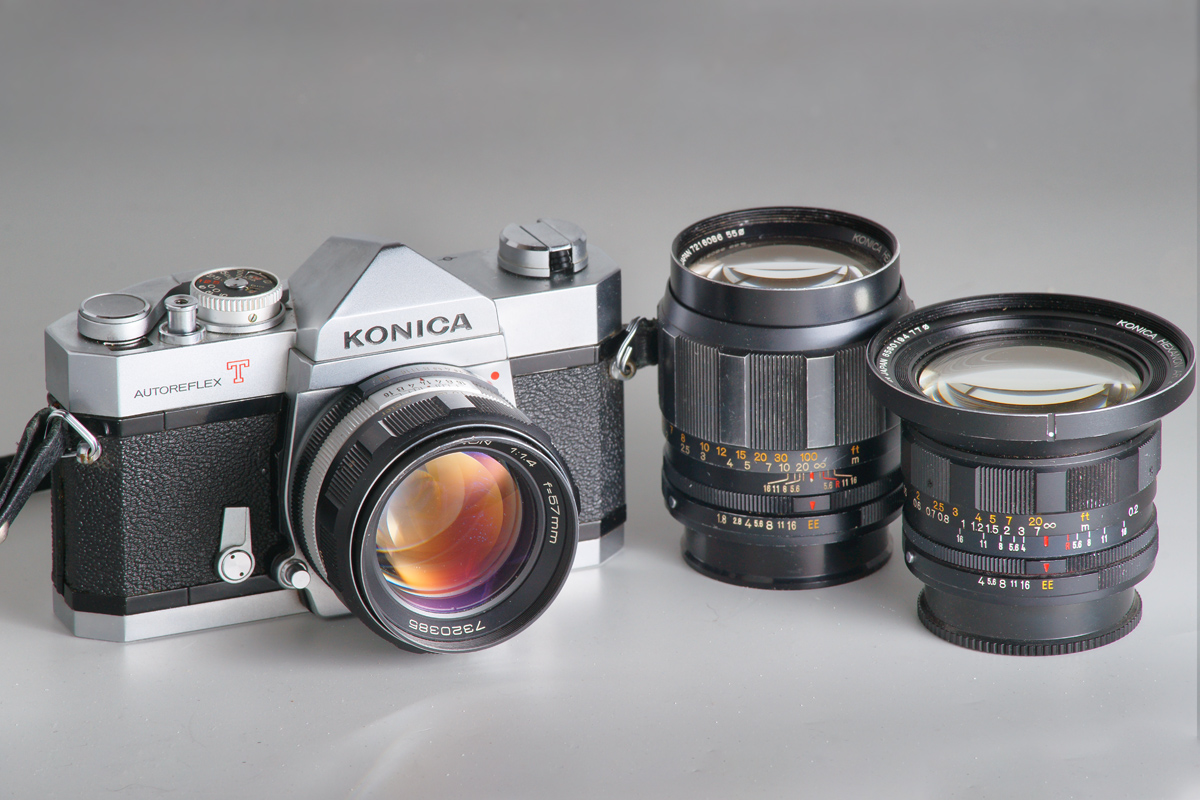
The coatings of the 1.4/57mm lens are really looking great if you you watch them at the right angle.
The Konica AR 1.8/85mm shown on the right of the Konica T is a very nice portrait lens. It has a rather low contrats wide open - which can be useful for portraits - but gets really excellent at f5.6. This early version has some slightly yellowish glass; later versions with rubber ring are more neutral in colors. I got this copy on a flea market for a really low price, somthing like CHF 8.-- as far as I remember.
The Konica AR 4/21mm is an early retrofocus superwide, and its lens section is extremely similar to the Carl Zeiss Jena Flektogon 4/20mm. However, the large single postive front lens of the Flektogon was replaced by a doublet, probably improving the color correction. The AR 4/21mm has an extremely uniform performance from f4 up to f16. This lens was part of a set which I bought a few years ago for about CHF 90.--.
S
_________________
www.artaphot.ch |
|
| Back to top |
|
 |
kansalliskala


Joined: 19 Jul 2007
Posts: 5028
Location: Southern Finland countryside
Expire: 2016-12-30
|
 Posted: Sun Feb 28, 2021 7:42 am Post subject: Posted: Sun Feb 28, 2021 7:42 am Post subject: |
 |
|
kansalliskala wrote:

really nice set!
_________________
MF: Kodak DCS SLR/c; Samsung NX10; OM-10; Canon T50
Zuiko 28/3.5, Distagon 35/2.8; Yashica ML 50/2;
Zuiko 50/1.4; S-M-C 120/2.8; Zuiko 135/3.5; 200/5;
Tamron AD1 135/2.8, Soligor 180/3.5; Tamron AD1 300/5.6
Tamron zooms: 01A, Z-210
Yashicaflex C; Київ 4 + Юпитер 8, 11; Polaroid 100; Olympus XA; Yashica T3
Museum stuff: Certo-Phot; Tele-Edixon 135; Polaris 90-190; Asahi Bellows; Ixus IIs
Projects: Agfa Isolette III (no shutter), Canon AE-1D (no sensor),
Nikon D80 (dead), The "Peace Camera"
AF: Canon, Tokina, Sigma Video: JVC GZ-MG275E |
|
| Back to top |
|
 |
stevemark

Joined: 29 Apr 2011
Posts: 3754
Location: Switzerland
|
 Posted: Wed Mar 10, 2021 8:53 pm Post subject: Posted: Wed Mar 10, 2021 8:53 pm Post subject: |
 |
|
stevemark wrote:
Another Minolta, the "downgraded X-700" aka X-500, here shown with the corresponding MD-III lenses 2/135mm and 2.8/200mm.
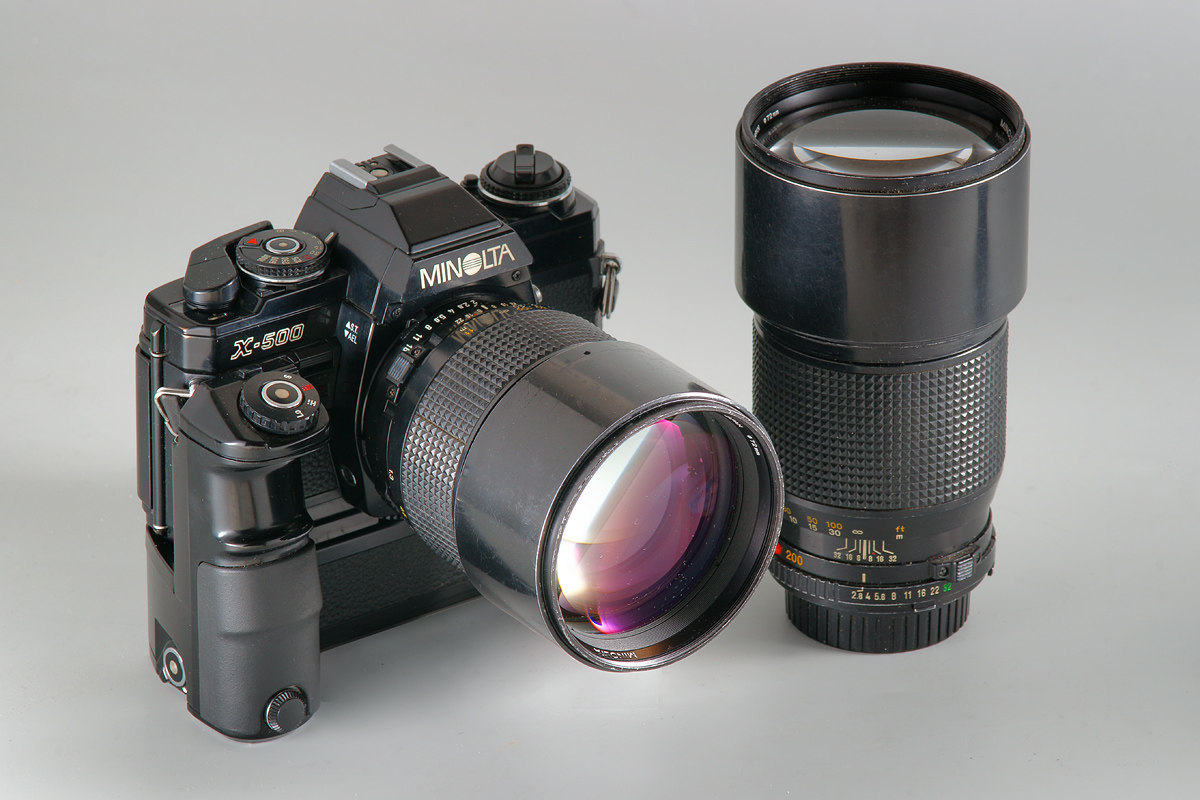
The X-500 and X-700 cameras have one of the very best SLR viewfinders I know - much larger than e. g. the later Nikon (D)SLRs. Both cameras should be combined with the Minolta MD-1 motor drive. This one, again, handles superior to the motordrives for the Canon New F-1 or the Nikon F3, but it is slower (only 3.5 fps).
The X-500 does have a few nice features which make it - in my opinion - more useful than the earlier X-700, among them the light metering in manual mode, and the TTL flash sync speed (fixed 1/60s with the X-700, variable / adjustable with the X-500).
S
_________________
www.artaphot.ch |
|
| Back to top |
|
 |
NikonAIS


Joined: 23 Mar 2014
Posts: 215
Location: Pawleys Island, SC, US
|
 Posted: Tue Mar 16, 2021 12:17 am Post subject: Posted: Tue Mar 16, 2021 12:17 am Post subject: |
 |
|
NikonAIS wrote:
| stevemark wrote: |
Probably the most sophisticated analog SLR ever built - the Minolta Dynax 7 (also known as Maxxum 7). Here's a nice set I just got yesterday, including the Minolta AF 3.5-4.5/24-105mm zoom, the Minolta AF 2/28mm fast wideangle and a 3600 HS D flash.

The Dynax 7 has a few features one would expect from a digital SLR, but not from a film camera - such as a kind of EXIF data recording, a LCD monitor on the back (which makes her look like an early DSLR), and lots of buttons.
EDIT:
Here's the rear side 

Doesn't she look like a real early DSLR? In fact around 1995-2000 Minolta did produce some of the technologically most advanced DSLRs. Sadly, the then head of Minolta (the son of its founder) was stubbornly convinced that digital photography would never succeed. It was his decision that the extremely expensive early Minolta DSLR (RD-175 [1995], and RD-3000 [1999]) would be put into the cheapest plastic SLR bodies available - and not into the beautiful full metal (stainless steel!) body of the Dynax 9!
So in the year 2000 the Dynax 7 was born. Would it have been a digital SLR (as the engineers wanted it to be) I'm pretty sure Minolta would still sell cameras today. When finally in 2004 the digital Dynax 7D came out, it was too late, even though the Dynax 7D is extremely well made given the fact that it is not a professional DSLR.
S |
What can it do that a Nikon F5 or F6 cannot do?
_________________
Nikon FTn, F2A, F3HP, F4E, F5, Nikkormat FT2, Nikon FE-2, Nikonos V, D850, D500 and D750. 8mm f/2.8 AIS, 16mm f/2.8 Fisheye AIS, 15mm f/3.5 AIS, 18mm f/3.5 AIS, 24mm f/2 AIS, 28mm f/2 AIS, 28mm f/3.5 Nikkor H non-AI, 25-50mm f/4 AIS, 28mm f/3.5 and 35mm f/2.8 UW-Nikkors, 35mm f/1.4 AIS, 50mm f/1.4 AIS, 50mm f/1.4 Nikkor-S, 50-135mm f/3.5 AIS, 55mm f/2.8 AIS Micro w/ PK-13, 80-200mm f/4 AIS, 85mm f/1.4 AIS, 105mm f/1.8 AIS, 10.5 cm f/2.5 non-AI, 105mm f/2.8 AIS Micro, 135mm f/2 AIS, 180mm f/2.8 ED AIS, 200mm f/4 Micro AIS and PN-11, 200mm f/2 ED-IF AIS, 300mm f/2.8 ED-IF AIS, 400mm f/2.8 ED-IF AIS, 500mm f/8 Reflex, 600mm f/4 ED-IF AIS, TC14B and TC300.
Hasselblad 500CM with PM-90 eye level finder and assorted A12 and A16 backs, Carl Zeiss C and CF T* 40mm f/4. 60mm f/3.5. 80mm f/2.8, 150mm f/4 and 250mm f/5.6
AF lenses are for sissies! |
|
| Back to top |
|
 |
DigiChromeEd


Joined: 29 Dec 2009
Posts: 3462
Location: Northern Ireland
|
 Posted: Tue Mar 16, 2021 1:20 pm Post subject: Posted: Tue Mar 16, 2021 1:20 pm Post subject: |
 |
|
DigiChromeEd wrote:



_________________
"I've got a Nikon camera, I like to take a photograph" - Paul Simon |
|
| Back to top |
|
 |
stevemark

Joined: 29 Apr 2011
Posts: 3754
Location: Switzerland
|
 Posted: Wed Mar 17, 2021 12:04 am Post subject: Posted: Wed Mar 17, 2021 12:04 am Post subject: |
 |
|
stevemark wrote:
The rather common Konica Autoreflex T4 SLR with Konica AR 1.4/50mm (2nd version). On the right two not-so-common Konica AR wideangle lenses, the AR 2.8/21mm and the AR 2.8/24mm II:

S
_________________
www.artaphot.ch |
|
| Back to top |
|
 |
Zamo

Joined: 08 Feb 2019
Posts: 163
|
 Posted: Wed Mar 17, 2021 10:40 am Post subject: Posted: Wed Mar 17, 2021 10:40 am Post subject: |
 |
|
Zamo wrote:
| stevemark wrote: |
The rather common Konica Autoreflex T4 SLR with Konica AR 1.4/50mm (2nd version). On the right two not-so-common Konica AR wideangle lenses, the AR 2.8/21mm and the AR 2.8/24mm II:
S |
Nice! Wouldn't mind having that 21mm. I have the f4 and it is a very good lens. But slower and bigger... |
|
| Back to top |
|
 |
DigiChromeEd


Joined: 29 Dec 2009
Posts: 3462
Location: Northern Ireland
|
 Posted: Wed Mar 17, 2021 7:09 pm Post subject: Posted: Wed Mar 17, 2021 7:09 pm Post subject: |
 |
|
DigiChromeEd wrote:


_________________
"I've got a Nikon camera, I like to take a photograph" - Paul Simon |
|
| Back to top |
|
 |
stevemark

Joined: 29 Apr 2011
Posts: 3754
Location: Switzerland
|
 Posted: Wed Mar 17, 2021 7:43 pm Post subject: Posted: Wed Mar 17, 2021 7:43 pm Post subject: |
 |
|
stevemark wrote:
| Zamo wrote: |
| stevemark wrote: |
The rather common Konica Autoreflex T4 SLR with Konica AR 1.4/50mm (2nd version). On the right two not-so-common Konica AR wideangle lenses, the AR 2.8/21mm and the AR 2.8/24mm II:
S |
Nice! Wouldn't mind having that 21mm. |
That's what I was thinking for years as well. A few days ago I found a small advertising saying "Konica T3 plus wideangle for sale". The lens, at first glance, did look very much like the ubiquituous AR 3.5/28mm. Since the price was rather steep for a T3 plus 3.5/28mm, nobody did look close enough to discover the AR 2.8/21mm ...
| Zamo wrote: |
| I have the f4 and it is a very good lens. But slower and bigger... |
I haven't compared the two AR 21mm lenses side by side. Fist impression is that the 4/21mm might be as good or even better than the 2.8/21mm, but I'm not sure yet. The 4/21mm doesn't change much when stopping down - it's rather good at f4, and not really exceptional at f11. The 2.8/21mm changes quite a lot when stopping down.
| DigiChromeEd wrote: |
 |
That black T3 looks gorgeous - I've only the chrome one. Actually the AR 2.8/21mm (as mentioned above) came with a like new Konica T3N plus an equally nice copy of the first version of the AR 1.4/50mm. Unlike most other Konica T/T2/T3 SLRs I own, this one did not have a stuck shutter!
| DigiChromeEd wrote: |
 |
Nice image of the first version of the AR 2.8/24mm - thanks for sharing!
S
_________________
www.artaphot.ch |
|
| Back to top |
|
 |
Blazer0ne

Joined: 12 Sep 2018
Posts: 836
Expire: 2024-12-07
|
 Posted: Wed Mar 17, 2021 8:11 pm Post subject: Posted: Wed Mar 17, 2021 8:11 pm Post subject: |
 |
|
Blazer0ne wrote:
...
Last edited by Blazer0ne on Tue Feb 22, 2022 6:34 pm; edited 1 time in total |
|
| Back to top |
|
 |
stevemark

Joined: 29 Apr 2011
Posts: 3754
Location: Switzerland
|
 Posted: Wed Mar 17, 2021 9:22 pm Post subject: Posted: Wed Mar 17, 2021 9:22 pm Post subject: |
 |
|
stevemark wrote:
| Blazer0ne wrote: |
| I would hardly call mine a test. Though, I noticed on cropped format APS-C at 2 meters focus the 21/4 clearly forms astigmatism where the 21/2.8 does not. However, the 21/.2.8 sometimes did have slight corner CA and the highlight shoulder roll off was a little harsh in full sun. I had blown highlights. That's with no shade. At MFD I have some photos with incredible center sharpness on the 21/2.8 and it looked fairly even across the frame. You should throw a minolta 21/2.8 into a test and see how it compares between the other two on full frame. |
Yep - Full Frame will give results quite different from APS-C. I first may compare only the AR 4/21mm and the AR 2.8/21. Later on other well known vintage 21mm and 20mm lenses may follow (FD 2.8/20, Mamiya CS 2.8/20, Minolta 2.8/21 and 2.8/20, Nikkor 2.8/20, Olympus 3.5/21, Pentax A 2.8/20, Topcon RE 4/20, and Yashica ML 3.5/21).
S
_________________
www.artaphot.ch |
|
| Back to top |
|
 |
stevemark

Joined: 29 Apr 2011
Posts: 3754
Location: Switzerland
|
 Posted: Wed Mar 17, 2021 9:50 pm Post subject: Posted: Wed Mar 17, 2021 9:50 pm Post subject: |
 |
|
stevemark wrote:
... and since we just are at it - here are the two lenses, AR 4/21mm and AR 2.8/21mm:
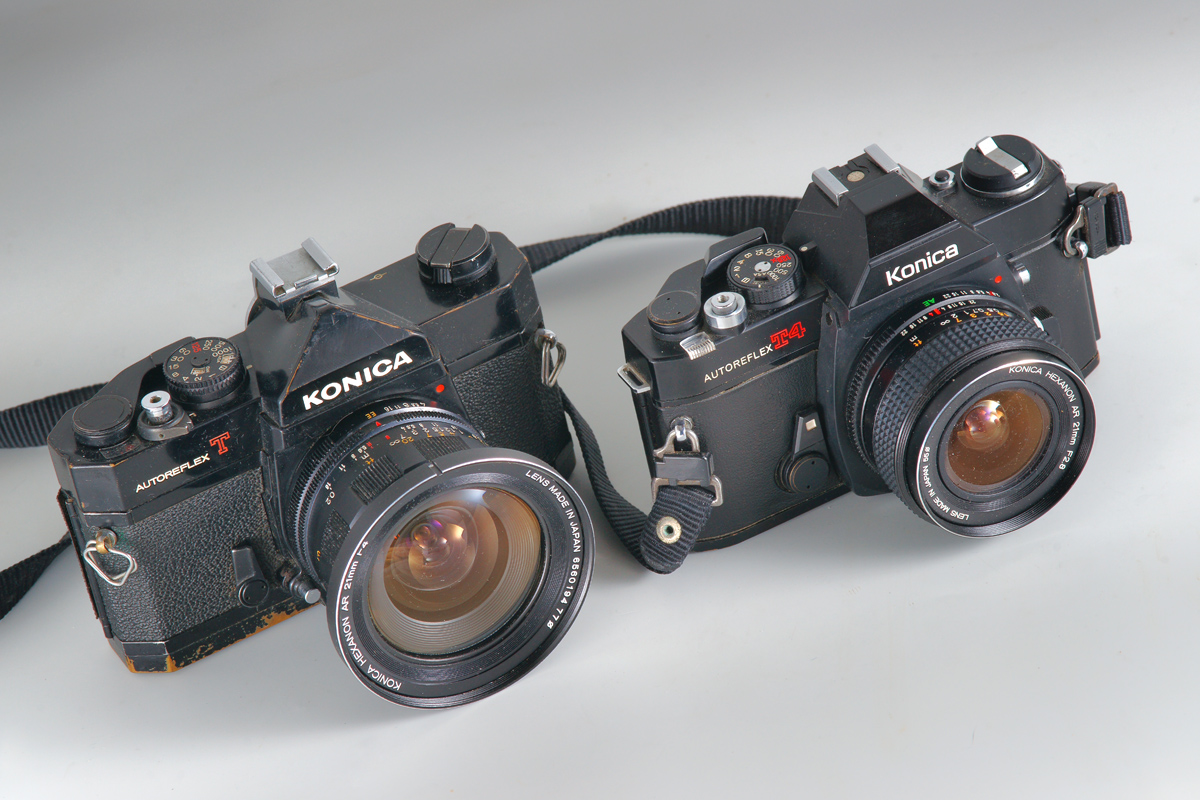
Of course DigichromEd's T3 is much better preserved than my T ...
S
_________________
www.artaphot.ch |
|
| Back to top |
|
 |
DigiChromeEd


Joined: 29 Dec 2009
Posts: 3462
Location: Northern Ireland
|
 Posted: Thu Mar 18, 2021 2:34 pm Post subject: Posted: Thu Mar 18, 2021 2:34 pm Post subject: |
 |
|
DigiChromeEd wrote:
My "twins"
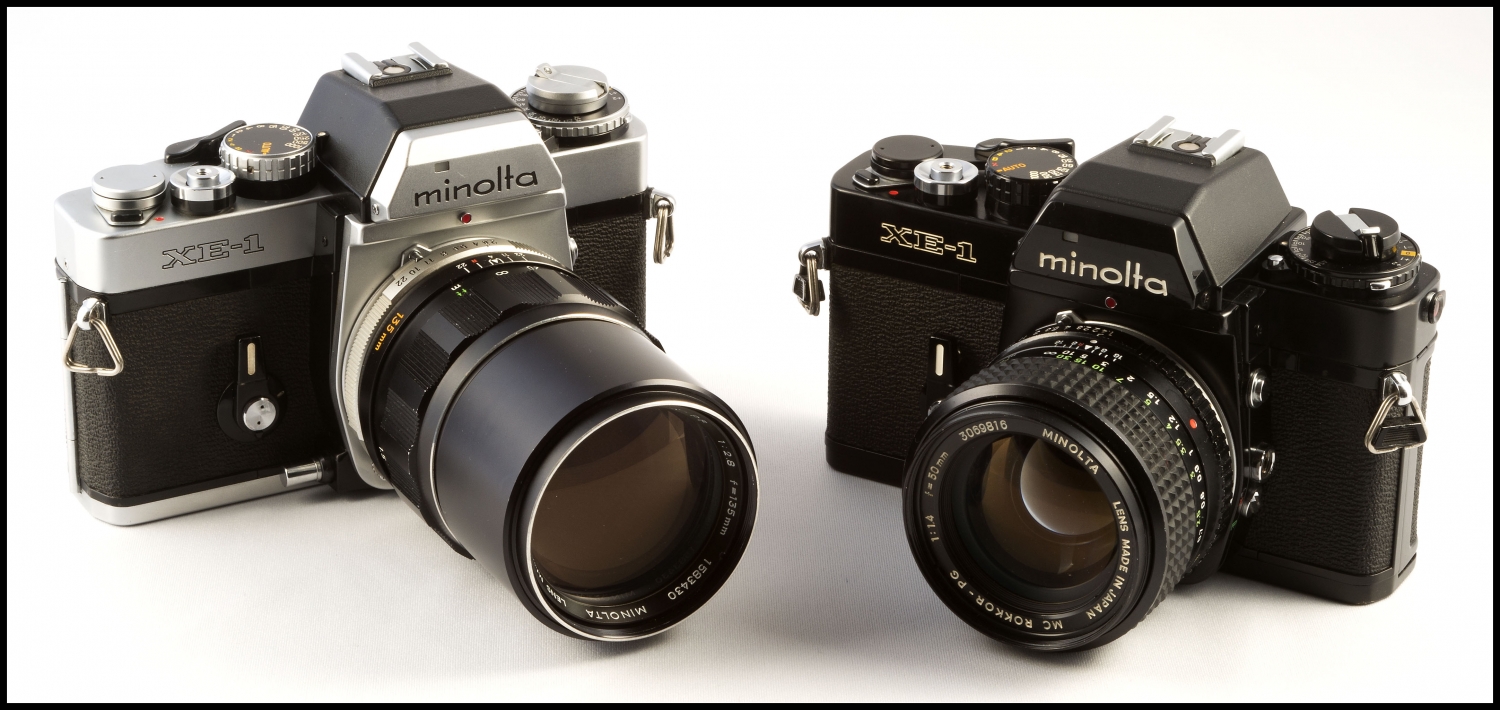
_________________
"I've got a Nikon camera, I like to take a photograph" - Paul Simon |
|
| Back to top |
|
 |
stevemark

Joined: 29 Apr 2011
Posts: 3754
Location: Switzerland
|
 Posted: Sun Apr 04, 2021 6:51 pm Post subject: Posted: Sun Apr 04, 2021 6:51 pm Post subject: |
 |
|
stevemark wrote:
| NikonAIS wrote: |
| stevemark wrote: |
Probably the most sophisticated analog SLR ever built - the Minolta Dynax 7 (also known as Maxxum 7).
... |
What can it do that a Nikon F5 or F6 cannot do? |
Sorry for my delayed answer. Here I'll only give a few hints; details (including images) will be published on artaphot.
I'll compare the Minolta Dynax 9 (less sophisticated than the Dynax 7, but a professional SLR) with the Nikon F5. Basically the two cameras have a similar performance:
* P-A-S-M mode
* EV range: 0-20 (Dynax 9 and F5, matrix metering)
* Shutter 30s - 1/12'000 (Dynax 9) vs 30s - 1/8'000 (F5)
* flash sync 1/300 (D9) vs 1/250 (F5); high speed sync 1/12000 (D9) and 1/8000 (F5)
* Flash metering: 14 segment (Dynax 9) vs 5 segment (F5)
* frame rate 5.5 fps (D9) vs 8 fps (F5)
* AF speed (with 1.4/50mm, S AF mode): similar for both cameras. AF C mode: probably better on F5 (five vs three AF sensors)
* AF range (EV): -1 - 18 (Dynax 9), -1 - 19 (F5)
* Body material: stainless steel (Dynax 9), aluminium (F5)
There are a few substantial differences:
* integrated viewfinder (Dynax 9) vs changeable viewfinder (F5)
* changeable battery pack / grip (D9) vs integrated battery / grip (F5)
* built-in flash (D9) vs no flash (F5)
The main differencs between the Minolta Dynax 7 / 9 and the Nikon F5 / F6 is the user interface (ergonomics). Simply said, the Minoltas are miles ahead for two reasons: 1) much better vertical grip, and 2) direct access to a vast number of functions (separate dials for all these function, no awkward "open the cover - press the button - turn the wheel" sequences, just a simple and direct straight access).
Here's the details wher the Dynax 7 and Dynax 9 are better:
* P-S-A-M mode directly accessible. Selected mode visible also when camera is off (even at night due to fluorescent letter!!)
* shutter speed / aperture control: front wheel is angled at about 50° and therefore much easier to use than the wheel of the F5 / F6. Not the cheapest solution to build, worth the trouble!
* Frame rate: Direct access for "Single" and "Continuos" (as in F5), but in addition also direct access for Bracketing (S and L) and multiple exposure (ME)
* AEL / AF buttons have a reasonable size (much too small on F5, improved on F6)
* AEL button induces "slow sync flash" when a flash is used. Extremely useful for reportage / marriages / concerts, especiially with the built-in flash of both the D7 and the D9 !!
* large double wheel for A) exposure compensation and B) flash exposure control (direct access!). Extremely useful.
* built in flash (guide number 12, angle sufficient for 24mm wide lens): Extremely useful for slide and color negative film - remember these were the times when ISO 400 was "high sensitivity". Gives well balanced color slides when used in artificial light with 5500K films.
* much better ergonomics in portrait format: A) reasonably shaped grip (the F5 grip is ridiculous) and B) both control wheels doubled for portrait format (no wheels on F5 grip!!) and C) AEL and EF buttons doubled (no such buttons on F5 grip)
* eye start for AF (AF activates as soon as you A) touch the main grip and B) look through the viefinder). Can be turned off - yes! - without going into menues!
* direct control (not via menu) of flash modes (normal - rear sync - red eye reduction - wireless)
* Camera directly controls the wireless flash mode (no "master flash" needed)
* much easier mirror lock up mode: 2s self timer is combined with MLU (retains AE mode which makes it much easier to use)
In addition - and here comes the "most sophisticated SLR" - the Dynax 7 has a few gimmicks that usually can be found only on DSLRs:
* large rear LCD screen
* nine AF sensors
* menu in different languages
* data back integrated in the camera
* memory module to save the data of about 1000 images (early EXIF system)
* 30 custom functions directly accessible via screen (no user manual needed!)
* sophisticated thumb control wheel on rear side (much more functions than on F5)
* Nice AF/MF button (no need to fiddle with the murky small selector on the F5), in addition to the traditional AF selector of course
* selector for the AF area (large [9 sensors], variable [any of the nine sensors quickly selectable], lock [one of the nine sensors permanently selected]
All that said - the mirrox box of the F5 is vastly superior to the mirror box of the Minolta Dynax 9: faster, less noise, and less vibration. And it was very well protected by Nikons patents, thus blocking the pathway for Minolt / Sony to create an equally fast "Minolta Dynax 9D" (aka Sony Alpha 900). To circumvent this, Sony had to give up the mirror. The rest is history ...
S
_________________
www.artaphot.ch |
|
| Back to top |
|
 |
stevemark

Joined: 29 Apr 2011
Posts: 3754
Location: Switzerland
|
 Posted: Tue Apr 06, 2021 11:45 pm Post subject: Posted: Tue Apr 06, 2021 11:45 pm Post subject: |
 |
|
stevemark wrote:
A few days ago I found a rather early "Miranda T" SLR, shown below. According to 1992 McKeowns it's the second only of the numerous Miranda SLR models, produced in the 1950s. The first version of the "Miranda T" (which distinguishes itself from the second model only by its "Miranda Camera Co" instead of the original "Orion Camera") was the first Japanese SLR with exchangeable prism finder - certainly a kind of milestone for Japanese camera history.
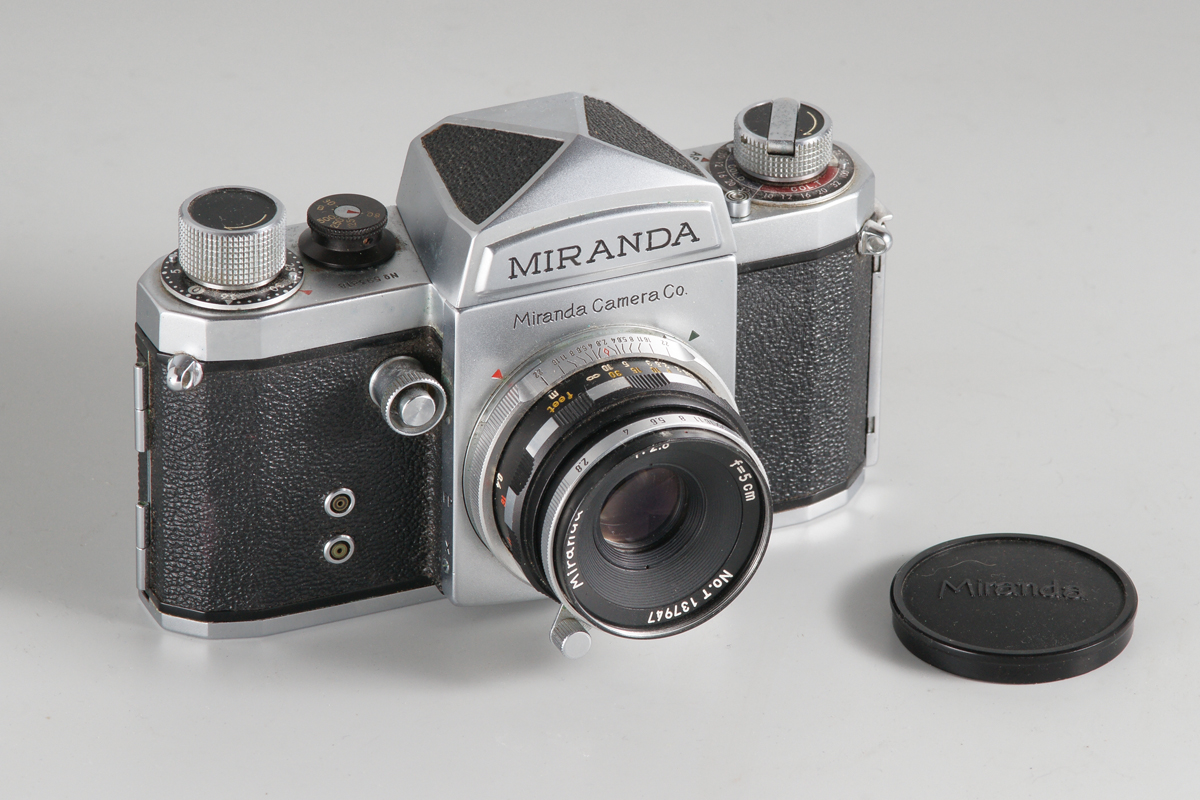
The shutter is a bit limited, going only from 1/30s to 1/500s. The camera is quite well made - maybe not as refined as a contemporary (early) Pentax, but certainly not much inferior. The viewfinder is surprisingly bright for a SLR from the 1950s (in daylight certainly much brighter than the rather dim EVFs we got used to during the last few years).
An interesting find indeed!
S
_________________
www.artaphot.ch |
|
| Back to top |
|
 |
HansMoleman


Joined: 12 Jul 2019
Posts: 145
Location: MD USA
|
 Posted: Thu Apr 08, 2021 12:42 am Post subject: Posted: Thu Apr 08, 2021 12:42 am Post subject: |
 |
|
HansMoleman wrote:
Nice find. Run a roll of film through her and post up some results........please. I love the photos by the older stuff. |
|
| Back to top |
|
 |
stevemark

Joined: 29 Apr 2011
Posts: 3754
Location: Switzerland
|
 Posted: Thu Apr 08, 2021 10:49 pm Post subject: Posted: Thu Apr 08, 2021 10:49 pm Post subject: |
 |
|
stevemark wrote:
| HansMoleman wrote: |
| Nice find. Run a roll of film through her and post up some results........please. I love the photos by the older stuff. |
Good suggestion - however the shutter has some bugs. The 1/30 actually acts as "T", the 1/60 and 1/125mm seem to be working, the 1/500 opens only partly, and probably the 1/250 is inaccurate. Pretty limiting - would result in approximatly f11 in daylight. Which means I could use any camera ... nothing specific or particular to be found in the images, I guess ...
Therefore I'd better go out with my late war Contax III which has been painstakingly restored by Henry Scherer (zeisscamera.com). Or with the rare "Linhof 220" 6x7 rangfinder camera ... which is really a strange camera, though probably an excellent one. Everything seems in fully working order, but I've never actually been using it. The fancy grip below the camera reminds of contemporary 16mm film cameras of course, but the whole setup feels rather shaky when shooting. It probably was developed as a replacement for the large fromat press cameras (such as the Graflex), but too late to make an impact. The Nikon F was the way to go.

The Contax III certainly isn't a small camera (comparable in size to a good SLR), but the Linhof 220 rangefinder is huge.
S
_________________
www.artaphot.ch |
|
| Back to top |
|
 |
marius.zaech


Joined: 27 Jan 2021
Posts: 53
Location: Switzerland
|
 Posted: Sun Apr 18, 2021 7:14 pm Post subject: Posted: Sun Apr 18, 2021 7:14 pm Post subject: |
 |
|
marius.zaech wrote:
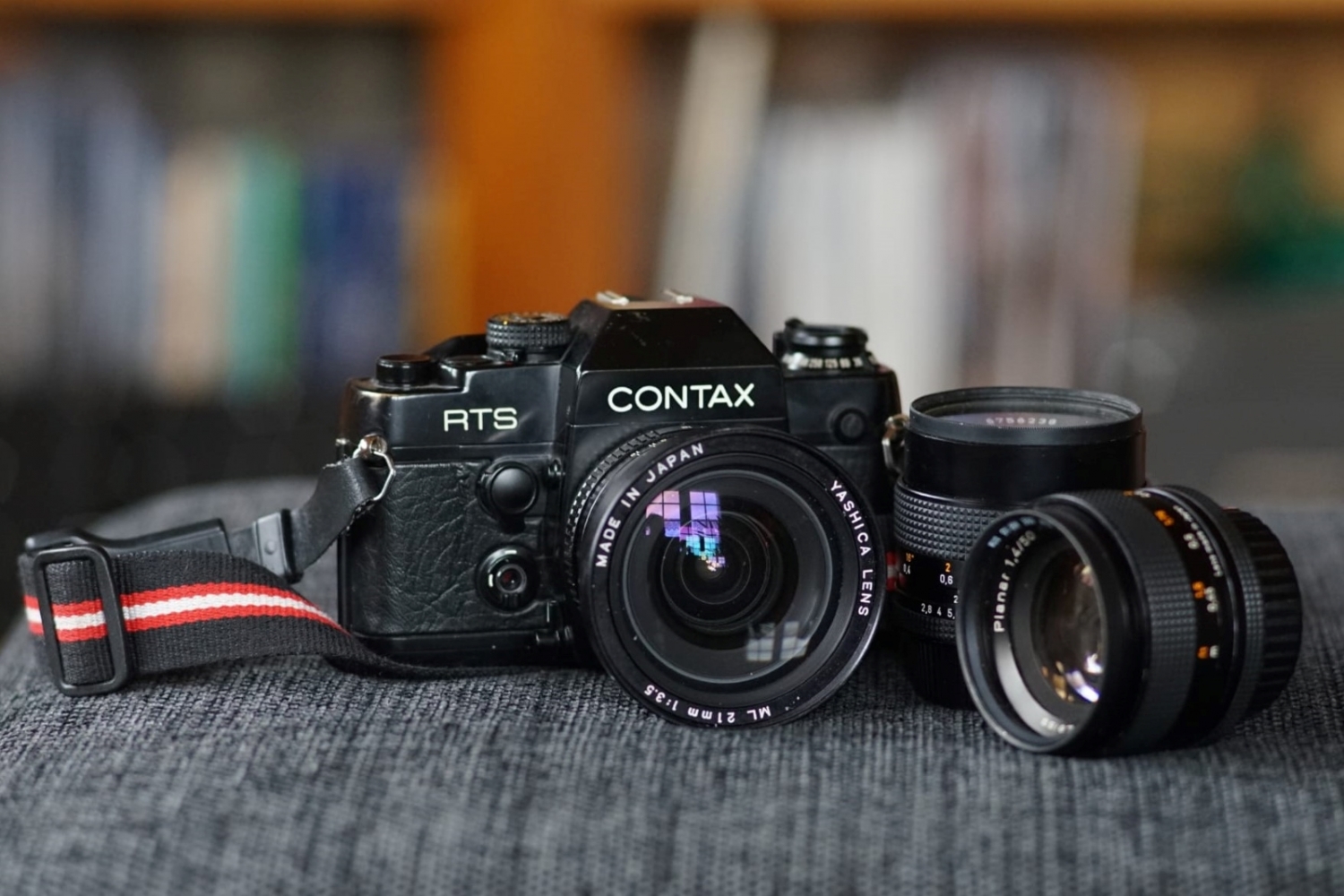
A heavy sucker but an absolute joy to use... especially with some nice Zeiss and Yashica glass such as the 21/3.5!! |
|
| Back to top |
|
 |
DigiChromeEd


Joined: 29 Dec 2009
Posts: 3462
Location: Northern Ireland
|
 Posted: Sun Apr 18, 2021 7:47 pm Post subject: Posted: Sun Apr 18, 2021 7:47 pm Post subject: |
 |
|
DigiChromeEd wrote:
Lovely! 
_________________
"I've got a Nikon camera, I like to take a photograph" - Paul Simon |
|
| Back to top |
|
 |
visualopsins


Joined: 05 Mar 2009
Posts: 10541
Location: California
Expire: 2025-04-11
|
 Posted: Sun Apr 18, 2021 8:37 pm Post subject: Posted: Sun Apr 18, 2021 8:37 pm Post subject: |
 |
|
visualopsins wrote:
| DigiChromeEd wrote: |
| (photos of black Spotmatic ES, black Spotmatic ES II, Spotmatic with Asahi Pentax Super-Lite flash, Spotmatic II with Asahi Pentax flash, and second Spotmatic with Asahi Pentax Autorobo flash |
   That's a real nice-looking set! That's a real nice-looking set! 
_________________
☮☮☮☮☮☮☮☮☮☮☮☮☮☮☮☮☮☮☮☮☮☮☮☮☮☮☮☮☮☮☮☮ like attracts like! ☮☮☮☮☮☮☮☮☮☮☮☮☮☮☮☮☮☮☮☮☮☮☮☮☮☮☮☮☮☮☮☮
Cameras: Sony ILCE-7RM2, Spotmatics II, F, and ESII, Nikon P4
Lenses:
M42 Asahi Optical Co., Takumar 1:4 f=35mm, 1:2 f=58mm (Sonnar), 1:2.4 f=58mm (Heliar), 1:2.2 f=55mm (Gaussian), 1:2.8 f=105mm (Model I), 1:2.8/105 (Model II), 1:5.6/200, Tele-Takumar 1:5.6/200, 1:6.3/300, Macro-Takumar 1:4/50, Auto-Takumar 1:2.3 f=35, 1:1.8 f=55mm, 1:2.2 f=55mm, Super-TAKUMAR 1:3.5/28 (fat), 1:2/35 (Fat), 1:1.4/50 (8-element), Super-Multi-Coated Fisheye-TAKUMAR 1:4/17, Super-Multi-Coated TAKUMAR 1:4.5/20, 1:3.5/24, 1:3.5/28, 1:2/35, 1:3.5/35, 1:1.8/85, 1:1.9/85 1:2.8/105, 1:3.5/135, 1:2.5/135 (II), 1:4/150, 1:4/200, 1:4/300, 1:4.5/500, Super-Multi-Coated Macro-TAKUMAR 1:4/50, 1:4/100, Super-Multi-Coated Bellows-TAKUMAR 1:4/100, SMC TAKUMAR 1:1.4/50, 1:1.8/55
M42 Carl Zeiss Jena Flektogon 2.4/35
Contax Carl Zeiss Vario-Sonnar T* 28-70mm F3.5-4.5
Pentax K-mount SMC PENTAX ZOOM 1:3.5 35~105mm, SMC PENTAX ZOOM 1:4 45~125mm
Nikon Micro-NIKKOR-P-C Auto 1:3.5 f=55mm, NIKKOR-P Auto 105mm f/2.5 Pre-AI (Sonnar), Micro-NIKKOR 105mm 1:4 AI, NIKKOR AI-S 35-135mm f/3,5-4,5
Tamron SP 17mm f/3.5 (51B), Tamron SP 17mm f/3.5 (51BB), SP 500mm f/8 (55BB), SP 70-210mm f/3.5 (19AH)
Vivitar 100mm 1:2.8 MC 1:1 Macro Telephoto (Kiron)
|
|
| Back to top |
|
 |
|
|
